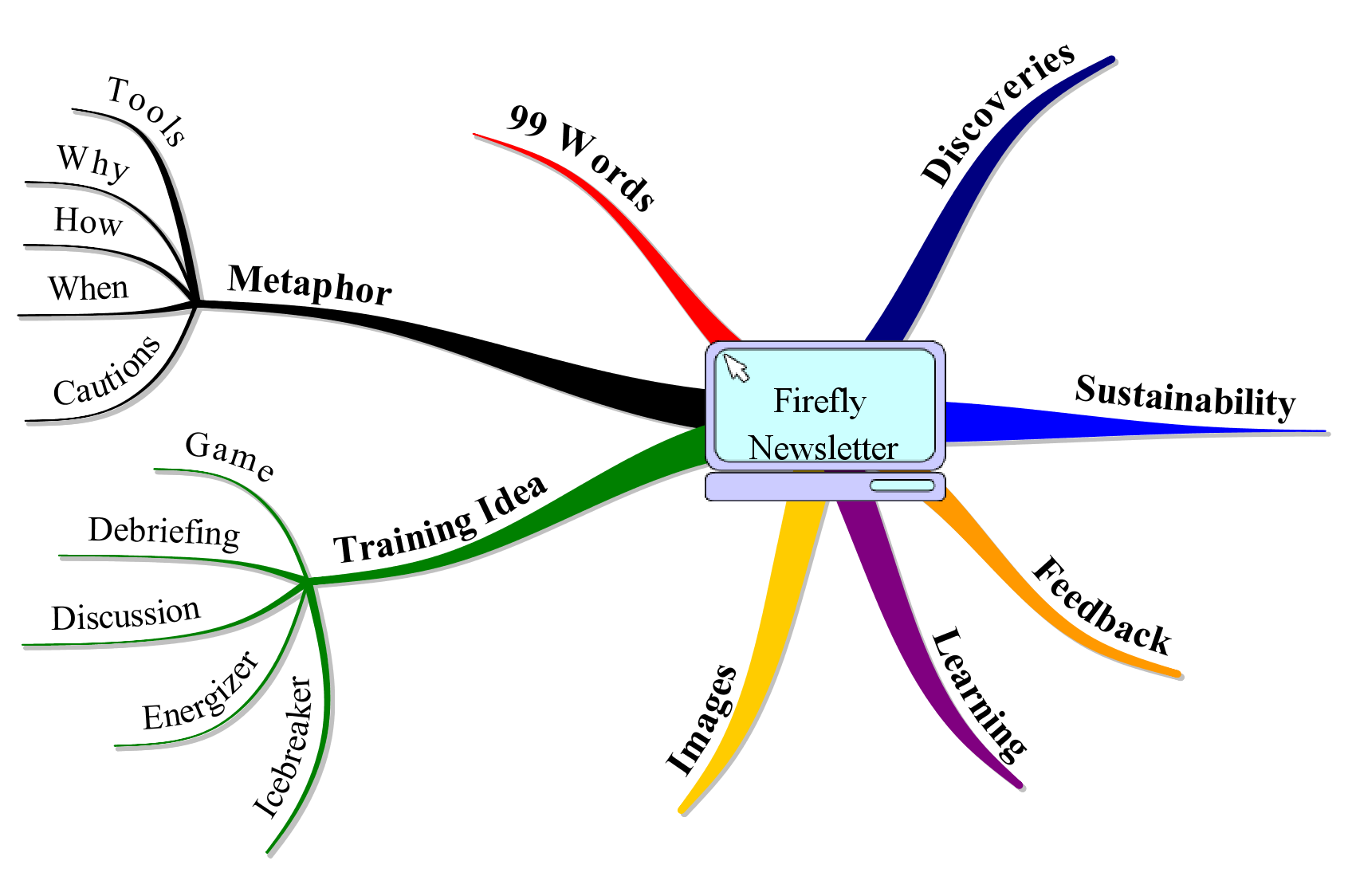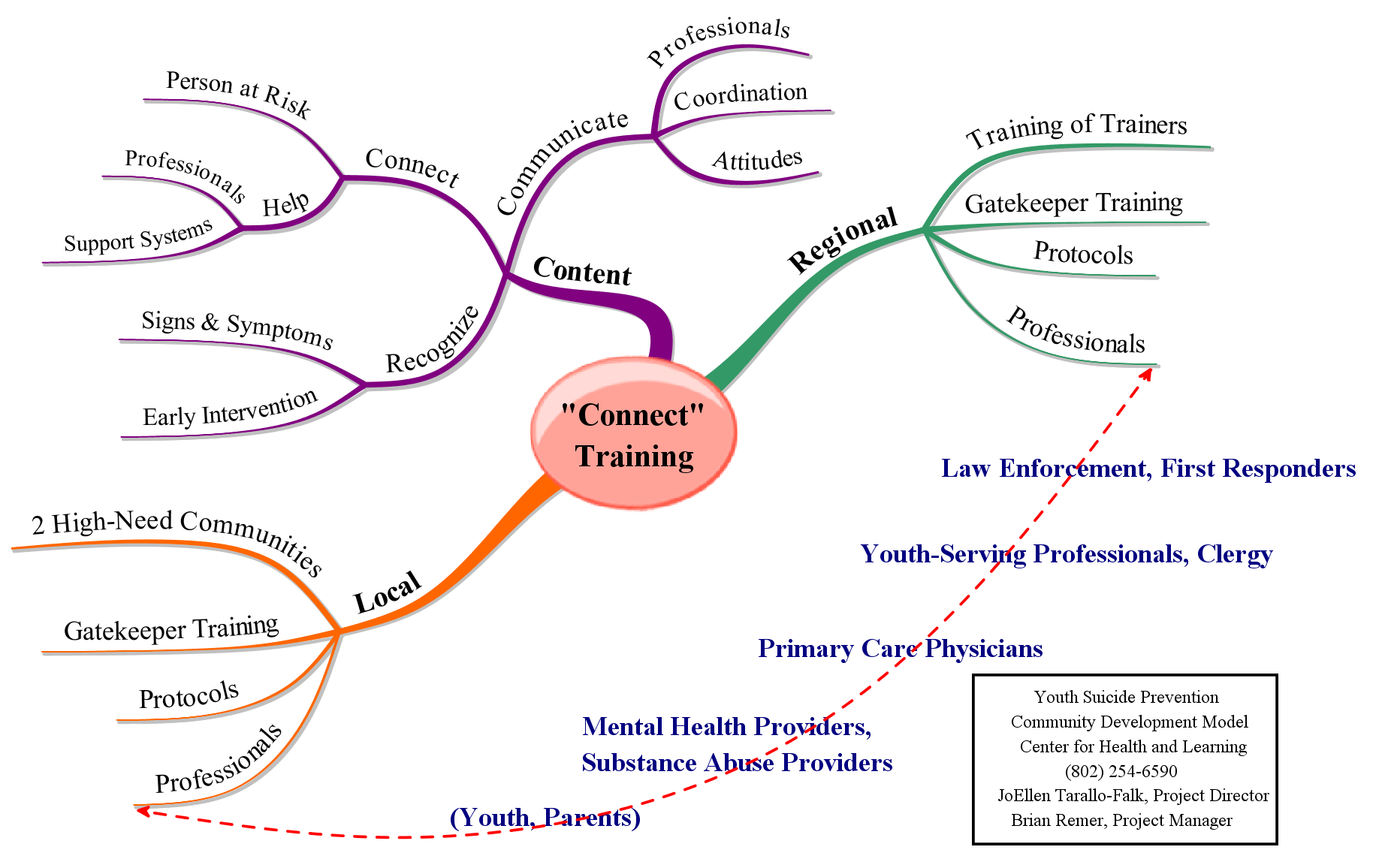


July 2009
In this Issue: BONUS - Complimentary StoryMatters Webinar
|
Say
It Quick |
Discoveries bits of serendipity to inspire and motivate |
Ideas fuel for your own continuous learning |
Activities tips and tricks you can try today |
| Seeing the Big Picture | Mind Mapping Tool | Out with Outlines! | Let Your Thoughts Wander |
Here, in only 99 words, you can see an example of the relationships that are revealed by looking at a whole system. Then click to this month's Discovery to learn about a tool for rendering big picture ideas.
Seeing the
Big Picture
I needed
to find my way through a large, unfamiliar metro area. Fortunately I was able
to borrow my sisterís car equipped with a GPS navigation system. With this
handy device I sliced through city traffic during rush hour with ease. I just
kept one eye on the readout and listened for the prompts.
But the trip wasnít without anxiety. Several times, the gentle metallic voice gave instructions that were counter intuitive. At 65 mph it was very disconcerting!
I realized that discrete instructions donít always make sense if you donít know the whole picture.
Mind
Mapping Tool
Buzonís iMindMap
 If
you could spend words like currency, a picture would be worth 1,000 of them,
right? Well, you can now get more bang for your buck since Tony Buzan introduced
iMindMap, a productivity tool for drawing and presenting ideas in a visual
format.
If
you could spend words like currency, a picture would be worth 1,000 of them,
right? Well, you can now get more bang for your buck since Tony Buzan introduced
iMindMap, a productivity tool for drawing and presenting ideas in a visual
format.
Buzan invented the concept of Mind Mapping which is a way of taking notes using words and pictures that are linked with branches to show their relationships and relative importance. A big attraction of the process is it's similarity to the way our brains work making organic connections between concepts and capitalizing on our capacity for visual thinking. Buzan's iMindMap application allows you to use this process as easily and as flexibly as you would a word processor Ė including the ability to cut and paste whole branches. In addition, you get color, graphics, an infinitely large drawing surface, and the ability to link to web pages, documents, and other files.
Use mind mapping to brainstorm, solve problems, plan an event, manage a project, take notes in a meeting, or describe a process. Plug your ideas into iMindMap and you also have a variety of ways to share them with others. The application allows you to export your mind map as a PowerPoint ģ presentation, a graphic, a spreadsheet, or a web page. You can save it as a dynamic presentation and reveal child branches one at a time or click on embedded hyper links as you talk about them. But most of all, I simply like being able to make changes without starting a whole new page as I would with pencil and paper.
There are other applications available to create mind maps on your computer but Buzan's has a polished look without appearing so professionally made that it can't be changed. Another great feature is that the structure you create, whether organic or symmetrical, stays that way until you decide to change it. Other programs are animated so that the highlighted node or branch bounces to the center of the screen. While this may be fun to watch, it can quickly make navigating your mind map confusing. iMindMap capitalizes on the brain's capacity for visual memory. The image isn't constantly changing and reference points are stable. A picture is memorable precisely because your brain doesn't have to come up with 1000 words to re-describe it!
 If
I want to dash off some ideas quickly, I'll always grab a sheet of paper and
a fistful of colored pens first. But if I want to tinker with those thoughts
or share them with someone else, I'll certainly use iMindMap. You can click
on the images here to see a larger view of them or visit Buzan's official
site to learn specifics about his application.
If
I want to dash off some ideas quickly, I'll always grab a sheet of paper and
a fistful of colored pens first. But if I want to tinker with those thoughts
or share them with someone else, I'll certainly use iMindMap. You can click
on the images here to see a larger view of them or visit Buzan's official
site to learn specifics about his application.
Out with Outlines!
I am
a victim of the Outline. Mrs. Hanson, my fifth grade teacher, insisted we
begin writing by organizing our thoughts in outline form. It seemed like I
was expected to have the whole paper in my mind all at once to write the outline.
Often I would forget an important thought while trying to figure out where
it fit in the hierarchy of Roman numerals and upper and lower case letters.
That process was overwhelming. I felt frustrated, discouraged, paralyzed.
On the other hand, my daughter is learning to write using a variety of mind mapping styles and techniques. Her teachers encourage her to get the ideas out of her head and onto paper before they slip away. Later she can concentrate on their order and create the connecting phrases that link them with a thread of consistency.
Our brains are designed to function as a network. Each neuron has branches extending to many, many other neurons. And it's actually the physical cell-to-cell connections that hold our memories. The brain doesn't create a hierarchical order of its neurons. So why not take advantage of that natural networking activity? Mind mapping does exactly that, yet, sometimes even I find myself slowed by trying to decide whether to add a branch at one level or another.
So lately I've been experimenting with a slightly different process. Whenever I have a thought or idea related to my topic, I write it down. Sometimes it's just a few words. Other times I end up with several sentences. I don't even think about order, consistency of thought, or even whether a particular idea should be included. If I see a word I've already written and am inspired, I add a few more to that thought. After a while, I start to notice similarities between ideas and begin clustering them together. As this continues, themes that I hadn't realized emerge and I can see the threads that will flow through the piece to make it a cohesive whole.
Even though Mrs. Hanson would not approve, my brain is happier and I enjoy writing more!
Let Your Thoughts
Wander
Create
an opportunity for yourself to experiment with mind mapping. Start simple
with whatever is on your mind, a To Do list or brainstorm of how to spend
your day off. Free yourself from having to think things through sequentially
from beginning to end. You might even try putting ideas down in arbitrary
locations on the page. Add a few random words that have nothing to do with
your mind map topic. Doodle some stick figures.
When you are tired of adding ideas, hold your paper at arm's length and look for relationships, similarities, or contrasts. Draw lines and links connecting those thoughts and images. What unexpected connections did you find? What clarity have you gained about which thoughts ought to be included?
Next, set your page aside and go for a walk, make something with your hands, or take a nap. When you return, examine your page anew. Turn it upside down. Squint at it with one eye. What shapes and images are suggested by the words and connections? How might those images be a metaphor for the topic or themes of your idea?
An unusual experiment? Perhaps, but that's the point of experimenting, to discover something uncommon. So be open to serendipitous insights and, when you find them, !
 StoryMatters
StoryMatters
by Terrence Gargiulo and Brian Remer
In the January 2009 News Flash, we featured StoryMatters, a recorded webinar which demonstrates how to use stories as a learning tool in the workplace. Here's an opportunity for you to participate in a live webinar of StoryMatters!
Save
the Date
July 15, 1:00 EST
This complimentary webinar will be loads of fun. It's a live edition of StoryMatters with Terrence Gargiulo and Brian Remer. Be in our virtual studio audience for Episode 7 and see how this employee engagement process works. We'll start with three 99 Word stories to trigger a flurry of stories, dialog, and insights that lead to performance improvement. And the best part of it all...your stories will be an integral part of the discussion!
Click HERE to sign up now!
In addition, Episode 6 is now available and I invite you to give it a listen. This installment offers lessons related to preventing, pacing, and presenting. You'll gain insight about how these three common concepts interact for both pain and profit in our personal and professional lives.
Listen or participate on line then what you think!
Read previous
issues. Click Archives!
To add or delete your name to our mailing list, email
with a short note in the subject line.
We want this newsletter to be practical, succinct, and thoughtful. If you have suggestions about how we can meet these criteria, please let us know! Send us an with your thoughts and ideas.
Home
| Services
| Products
| Mission
| Ideas |
The Group
| The Buzz
(c)
2005 The Firefly Group